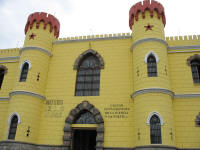|
Costa Rica: San Jose

|
|
San Jose
We took a boat, a taxi, a bus, and another taxi to get from the island in Panama to our hotel in the capital of Costa Rica. All in all, it was a grueling journey to an uninspiring city. San Jose enjoys one of the best climates year round, in that Goldilocks zone of not-too-hot, not-too-cold, but it was bleak and drizzling the evening we arrived. The museums were closed already and the shops were shutting down, so we decided the best thing to do was to take a taxi to the mall and watch a movie.
Sometimes, the most interesting thing to do in a foreign city is something totally ordinary—just to see what it would be like to be a normal person and not a tourist in that place. The traffic was horrendous and it took us at least a half hour to get across town to the mall. The mall was quite nice and very similar to any mall in the U.S. We located the cinema and purchased tickets for Ocean’s 13 in English with Spanish subtitles, and then headed to the food court for supper. It was here that we first experienced the culinary delight known as tres leches—three milks. It is essentially a sweet, soggy cake with whipped cream on top that is a traditional desert in Central America. It was delicious. The movie was also good.
|
|
|
|
|
|
|
|
|
Children’s Museum
We decided that we didn’t want to dawdle in this city when Costa Rica had so much more to offer than the dull cityscape of San Jose. So the next morning, we went to the bus station to buy a ticket to our next destination, but the bus didn’t leave until 2:30pm. We spent the rest of the morning at the Children’s Museum, which is housed in a renovated prison. It was the coolest museum ever, with lots of hands-on activities for kids to learn about science. We weren’t kids and we could only understand about half of the inscriptions in Spanish, but we had a great time.
|
 |
|
|
|
|
|
|
|
Don’t drink the water or flush the toilet paper
Costa Rica wasn’t much different from Pamana except in a few specific details. The currency was no longer trusty greenbacks, but colorful colones at a rate of 500 to $1. Things were also slightly more expensive, with a typical plate at a cheap restaurant costing about 2,500 colones, or $5, not including drinks. In Costa Rica, we could no longer drink tap water or flush toilet paper, as we had done in Panama. And the buses in Costa Rica were not pimped-out ex-U.S. school buses.
|
|
   |
|